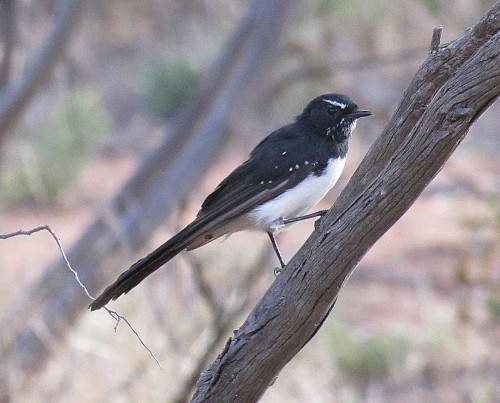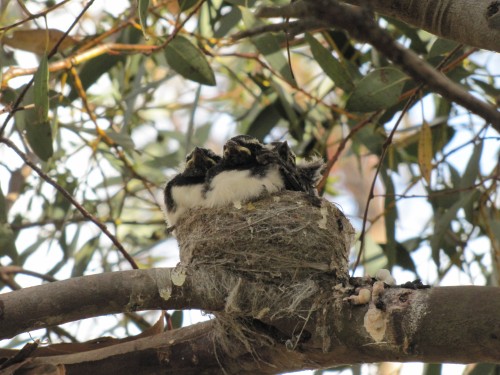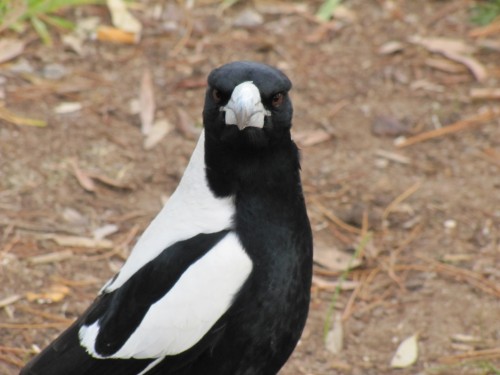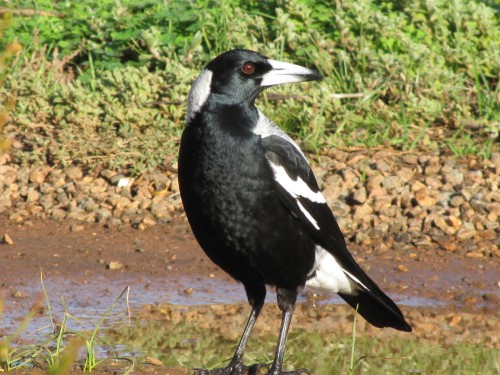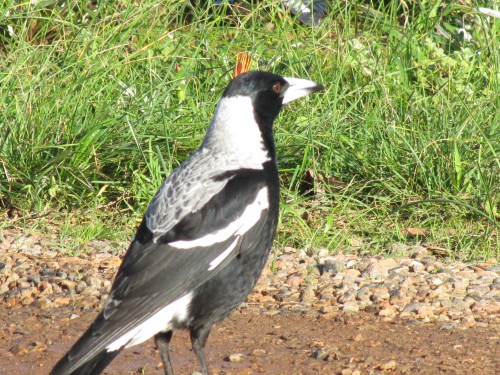A feisty Willie Wagtail
One of the most recognisable Australian birds would be the Willie Wagtail (see photo above). It is also one our most endearing birds, a favourite of many people. It loves occupying spaces close to human habitation, especially our gardens. We have a resident pair in our garden and we see them on a daily basis.
I have always known that Willie Wagtails can also be aggressive, feisty little birds. This has been in evidence in recent days in our garden, illustrated by the following incidents when it has attacked other, much larger species:
- Australian Magpies: our resident Magpies must be nesting somewhere on our five acre property here in South Australia. The male is consistently chasing almost every bird which comes near. Fortunately us humans are never swooped. Last Saturday, however, the roles were reversed. It was the magpie being chased – by a very aggressive and angry Willie Wagtail snapping at its tail as it tried to escape its wrath.
- Little Ravens: We often have small flocks of Little Ravens in our garden, usually up to about six or so. Yesterday I heard and then saw three ravens in the large mallee trees at the back of our home. As usual, they were cawing loudly. This attracted the attention of the Willie wagtail who rapidly came into the situation and began snapping at a raven’s feathers, tail and head, harassing the poor bird mercilessly. As soon as one raven flew off with a few caws in protest, the Willie Wagtail would turn its attention to another until all three were well and truly seen off the property.
Wedge-tailed Eagles
I have only observed Australia’s largest bird of prey, the Wedge-tailed Eagle, on one occasion here in over 30 years. It is, however, quite a common bird throughout this part of the country and I have seen the species on many occasions in my travels. It always amazes when the tiny Willie Wagtail – not much bigger than a humble House Sparrow – aggressively attacking the eagle, snapping at it and even pecking at its back while hitching a ride. Such courage – one snap of the eagle’s beak would dismiss the wagtail permanently.
The reason for this aggressive attitude:
Normally the Willie Wagtails are friendly, docile birds. They will allow all manner of birds to cohabit happily in our garden. The reason for this sudden change of attitude is a simple little nest, like the one shown below. The photo below was taken a few years ago because I don’t want to disturb the mother Willie wagtail. She is currently sitting on two lovely eggs. She is not even afraid to come after me when I get near to the nest, snapping near my head until I move a reasonable distance from the nest.
The weeds near the nest will just have to wait a few weeks to be mown. Sigh.
I recently wrote about other birds nesting in our garden (click here).
The problem of swooping magpies
It’s magpie swooping time again.
At this time of year people in many places around Australia are ducking for cover. It is magpie swooping time again. Around July and onwards our Australian Magpies start building or refurbishing their nests ready for the breeding season. Once the female has laid to eggs she is the only one to hatch them. Meanwhile, the male keeps guard over his territory.
Territorial
This species is highly territorial and disputes over their patch are hotly contested. On our five acre (2 hectare) property we have three intersecting territories, so the conflict can sometimes get quite boisterous. Once nesting commences, these bird wars calm down. You could say that they are real life “angry birds”.
Attacks
The fighting doesn’t always end there, however. While the female is sitting on the eggs, or the young are being fed while still in the nest, the male can be very aggressive in guarding his territory against anything, or anyone, he sees as a threat to the success of his progeny. Animals – including dogs, cats, foxes – other birds, walkers, gardeners, joggers and anyone misguided enough to venture within a hundred metres or so of the nest are all fair targets. Cyclists are a particular object of attack.
Damage
The male magpie will usually wait until the target has passed by, and will then attack from behind, a swift, smooth, nearly silent swoop aimed at the head. A swoosh of the wings and a few snaps of the beak from less than a metre behind is often the only warning one gets. By then it is too late. If contact is made the result can be both frightening and bloody. Their sharp beak can inflict a nasty break in the skin, and in a worst case scenario they have been known to damage an eye.
Preventing being swooped
So – what can one do to prevent getting swooped? I recently read this great list which was published here in South Australia in Weekend Plus: a digital magazine for seniors.
“We do need to take care around them because they have sharp beaks and claws and if they make contact, they can draw blood.
“The good news is that swooping season only lasts about six weeks, beginning when the eggs hatch and finishing when the young birds leave the nest.
“The best way to avoid being swooped is to change your route if possible, as they’ll only swoop within 50m of their nests.”
More tips for surviving the spring swoop
- Avoid making eye contact with magpies.
- Walk, don’t run past their nests.
- Travel in groups where possible as swooping birds generally target individuals.
- Carry an open umbrella or wear sunglasses and a broad-brimmed hat.
- If you’re riding a bike, walk your bike through magpie territory or attach a flag to the back that is taller than your head.
- Don’t wave your arms or shout – this just proves you are a threat to the nest.
- If you know of a swooping magpie, put up a sign to warn others.
Further reading:
- Do Blackbirds swoop? How to deal with aggressive birds.
- A bit on the nose – a humorous close encounter with a bird
- Magpies behaving badly
- Bird wars
- Aggressive bird behaviour in the garden
Noisy Miners causing problems
As I wrote here a few days ago I am currently visiting my daughter in Ethiopia and doing some interesting birding on the side. You’ll have to wait until the New Year to see photos of the amazing birds I am seeing.
About a week ago I had an urgent email from a journalist with our daily newspaper “The Advertiser” which is distributed throughout South Australia. She was asking permission to publish one of my bird photos in the Saturday edition. The accompanying article explained how Noisy Miners, a protected Australian native bird, are causing many problems in gardens around our capital city, Adelaide. Many are calling for a cull of this species due to their aggressive nature towards other native bird species, especially small birds like Red-browed Finches.
I didn’t bring my computer with me as I am using my daughter’s. I couldn’t supply the journalist with a high resolution photo for the paper. So I referred her to my son who managed, with some clever lateral thinking and searching, to find the photo on our backup files. The article went ahead featuring my photo.
You can see the photo and read the article here: Scientists want noisy miner cull.
Good birding.
Magpies up close and personal part 2
Yesterday I wrote about a family of Australian Magpies that joined us for afternoon tea in a roadside rest area south east of Mildura. Today I include several more photos taken at that time.
You can buy a photo of a magpie on a coffee mug – click here.
Magpies up close and personal
Sydney Trip June 2011
Over recent days I’ve been writing about the birds seen on the return trip from a holiday with family in Sydney. Today I want to show a series of photos taken at the Malleefowl Rest Area south east of Mildura. we had stopped for an afternoon cuppa and a light snack of biscuits. we had just sat down at the picnic table and we were immediately accosted by a family of Australian Magpies (ssp black backed), including several juveniles from last season’s breeding.
The whole family gathered on and around the table waiting for handouts of whatever food we had in our picnic basket. I guess they are used to being fed generously by any humans who happen to drop in to their domain. If we hadn’t been smart about covering the biscuit tin they would have helped themselves.
I took the opportunity to get some very close up photos of the magpies as they sat nearby or on the table less than a metre from me. Some – like the one above – are decidedly nasty looking.
Tomorrow I’ll show several more photos.
You can buy one of my photos of a magpie on a coffee mug – click here.
